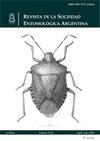潘潘农业生态系统中的花蝇(直翅目:蝇科):一个研究案例
IF 0.5
4区 农林科学
Q4 ENTOMOLOGY
引用次数: 1
摘要
农业生态系统对原始环境的结构和功能产生深刻的变化,主要是由于生物多样性的减少。花蝇(双翅目:蚜蝇科)是一种潜在的有益生物,它们提供了多种生态系统服务。我们研究了潘潘亚农业生态系统中收集的蚜虫,以评估它们的丰富度、丰度、寄主植物和它们可以提供的生态系统服务。花蝇隶属3亚科8部落17属26种/形态种。成虫对44种野生和栽培植物的花进行了访花,并表现出广泛的相互作用模式。幼虫种类最多的是捕食者(以软体半翅目为主)和/或分解者/水生过滤器。只有一种是授粉的。我们的研究结果,连同稀缺的已发表的文献资料表明,高度改良的潘潘地区的麻蚜群落是由少数非常丰富的物种和许多罕见或低代表性的物种组成的。本文章由计算机程序翻译,如有差异,请以英文原文为准。
Flower flies (Diptera: Syrphidae) in Pampean agroecosystems: a study case
Agroecosystems produce profound alterations on the structure and functioning of the original environment, mainly due to the reduction of biodiversity. Flower flies (Diptera: Syrphidae) are potentially useful organisms for the diverse ecosystem services they provide. We studied syrphids collected in a Pampean agroecosystem to assess richness, abundance, host plants, and the ecosystem services they could offer. Flower flies were represented by three subfamilies, eight tribes, 17 genera, and 26 species/morphospecies. Adults of these flies visited flowers of 44 species of wild and/or cultivated plants and exhibited a generalist interaction pattern. Larvae of the most abundant species were predators (mainly soft-bodied Hemiptera) and/or decomposers/aquatic filters. Only one species was pollinivorous. Our results, together with the scarce published bibliography, suggest that the syrphid communities of the highly modified Pampean region are composed of a few very abundant species and many rare or low representative species.
求助全文
通过发布文献求助,成功后即可免费获取论文全文。
去求助
来源期刊

Revista De La Sociedad Entomologica Argentina
Agricultural and Biological Sciences-Insect Science
CiteScore
0.80
自引率
20.00%
发文量
31
审稿时长
20 weeks
 求助内容:
求助内容: 应助结果提醒方式:
应助结果提醒方式:


